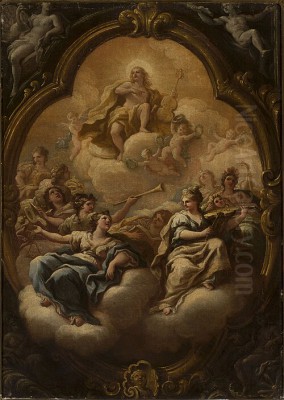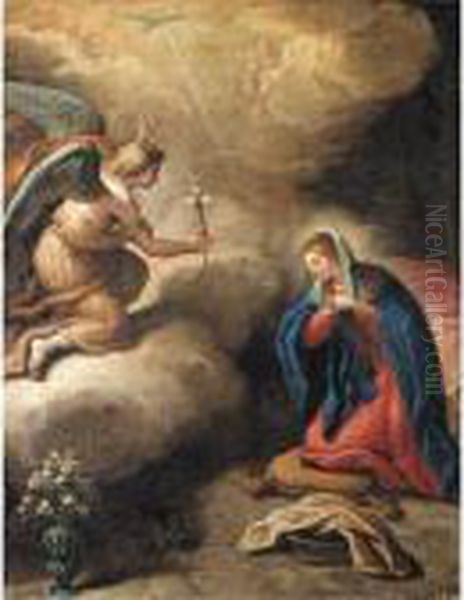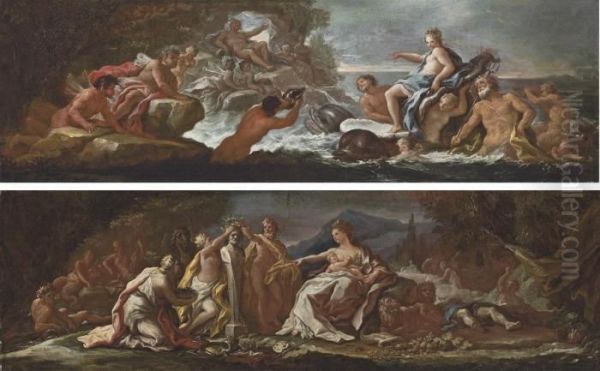
Paolo de Matteis stands as a significant figure in the landscape of Italian art during the late Baroque period. Active primarily in Naples, his work reflects the transition of styles at the turn of the 18th century, blending the dramatic intensity of the Baroque with the emerging elegance of the Rococo. His prolific output, particularly in frescoes and altarpieces, secured his reputation as a leading artist in Southern Italy.
Early Life and Artistic Formation
Paolo de Matteis was born on February 9, 1662, in Piano Vetrale, a small village near Oria in the southern Italian region of Apulia. Seeking artistic training, he moved to the vibrant cultural hub of Naples. This city, a major European capital, boasted a rich artistic tradition, particularly in painting, making it an ideal place for an aspiring artist to hone his craft.
In Naples, de Matteis had the invaluable opportunity to study under one of the most celebrated painters of the era, Luca Giordano (1634-1705). Giordano, known for his astonishing speed and versatility ("Luca fa presto"), was a dominant force in Neapolitan and European Baroque painting. Training in Giordano's workshop would have exposed de Matteis to a dynamic, high-Baroque style characterized by vibrant colors, energetic compositions, and dramatic narratives. The source material also mentions him studying under a "Morandi," though Giordano's influence is generally considered paramount in his early development.
Stylistic Evolution: From Baroque Drama to Rococo Grace
Paolo de Matteis's artistic style is often characterized as a synthesis of late Baroque and early Rococo elements. His initial work clearly shows the impact of Luca Giordano, but over time, de Matteis developed a more personal manner marked by elegance, refinement, and a certain delicacy. He became particularly adept at depicting religious and mythological scenes, imbuing them with a graceful sensibility.

His paintings are noted for their sophisticated compositions and his skillful handling of light, shadow, and color. While capable of Baroque drama, his figures often possess a softer, more idealized quality than those of some of his predecessors like Jusepe de Ribera (1591-1652) or Mattia Preti (1613-1699). His palette could range from rich Baroque hues to the cooler tones mentioned in relation to works like The Triumph of the Immaculate, demonstrating versatility.
Sources indicate that de Matteis was influenced by the cultural atmosphere of Rome, where he spent some time. This exposure likely contributed to a classicizing tendency observed in some of his works, particularly later in his career. Furthermore, his style is seen as anticipating the full-blown Rococo manner that would later be championed in Naples by Francesco Solimena (1657-1747), another giant of the Neapolitan school. De Matteis's art, therefore, serves as an important link between the high-energy Baroque of Giordano and the more decorative, lighter Rococo aesthetic. The influence of Arcadian ideals, emphasizing pastoral harmony and idealized beauty, can also be discerned in his approach to certain themes.
Major Works and Thematic Concerns
Throughout his career, Paolo de Matteis was highly productive, receiving numerous commissions for churches and private patrons primarily in Naples, but also elsewhere, including Rome. His oeuvre includes large-scale frescoes, altarpieces, and easel paintings.
Among his representative works mentioned in art historical accounts are:
_The Fall of the Heavenly Beings_ (1693): An early work likely showcasing his capacity for dynamic, multi-figure compositions, possibly reflecting Giordano's influence in its dramatic subject matter.
_The Annunciation_ (1712): This later work likely exemplifies his mature style, perhaps blending devotional sentiment with Rococo elegance.
_The Triumph of Galatea_: Considered a typical Baroque piece, this painting depicts the mythological scene of the sea nymph Galatea triumphing over the Cyclops Polyphemus. It is noted for its dramatic flair, visual impact, and potential inspiration drawn from Luca Giordano. The theme symbolizes the victory of love and order.
_The Triumph of the Immaculate_: Described as a Baroque "fantasy narrative," this work highlights de Matteis's skill in creating vivid, complex scenes, possibly utilizing cooler tones to enhance the dramatic storytelling and emotional tension.

He also executed significant decorative cycles and altarpieces in Neapolitan churches, such as frescoes depicting the _Assumption of the Virgin_ and the _Baptism of St. John_. These large-scale works demonstrated his mastery of complex compositions and his ability to integrate painting within architectural settings, a hallmark of Baroque decoration. His activity extended to Rome, where he notably worked on frescoes for Pope Innocent XIII (reigned 1721-1724), indicating his high standing and recognition beyond Naples.
Connections and Artistic Milieu
Paolo de Matteis operated within a rich and competitive artistic environment. His primary connection was undoubtedly to his teacher, Luca Giordano, whose legacy profoundly shaped the Neapolitan school. De Matteis built upon Giordano's foundations but carved out his own niche. He is often discussed in relation to Francesco Solimena, his slightly older contemporary who would come to dominate Neapolitan painting in the first half of the 18th century. While distinct, their styles share certain affinities, particularly in the move towards a lighter, more elegant aesthetic compared to the earlier Baroque.
During his time in Rome, de Matteis reportedly had contact with other significant artists. The sources mention interactions with Antonio Balestra (1666-1740), a Veronese painter active in Venice and Rome known for his classical tendencies, and Jacopo Amigoni (1682-1752), a Venetian painter who became a major exponent of the international Rococo style, working across Europe. These encounters underscore de Matteis's participation in the broader Italian artistic discourse of the time, engaging with figures like the prominent Roman painter Carlo Maratta (1625-1713) or younger contemporaries like Sebastiano Conca (1680-1764).
While specific details of collaborations might be scarce, his known associations place him firmly within the network of leading Italian painters of his generation. He navigated the artistic currents flowing between Naples and Rome, absorbing influences while contributing to the evolving tastes of the period. His work stands alongside that of other Neapolitan painters like Bernardo Cavallino (1616-1656), though Cavallino represents an earlier, more poetic strand of the Neapolitan Baroque.
Legacy and Art Historical Assessment
In the grand narrative of Baroque art history, Paolo de Matteis holds a respectable position, particularly within the context of Naples. He is recognized as an important painter, especially skilled in large-scale decorative works that adorned churches and palaces. His ability to synthesize the energy of the late Baroque with the nascent grace of the Rococo marks him as a key transitional figure.

However, compared to towering figures like Michelangelo Merisi da Caravaggio (1571-1610), whose dramatic realism revolutionized painting, or Peter Paul Rubens (1577-1640), the Flemish master of Baroque dynamism, de Matteis's influence is considered more localized and perhaps less transformative. Art historical assessments sometimes characterize his style as becoming somewhat simplified or classicizing in his later years, moving away from the high drama of his predecessors.
Despite this, his contribution remains significant. He successfully carried forward the tradition of large-scale decorative painting in Naples after Giordano, maintaining a high level of technical skill and adapting his style to changing tastes. His elegance and refinement appealed to patrons, and his works remain important examples of Neapolitan painting in the late 17th and early 18th centuries. He passed away in Naples on January 26, 1728, leaving behind a substantial body of work that testifies to his skill and his role in the artistic life of his time.
Conclusion
Paolo de Matteis was a talented and prolific painter who played a vital role in the Neapolitan art scene during a period of stylistic transition. As a student of Luca Giordano, he inherited the dynamism of the High Baroque but forged his own path, developing a style characterized by elegance, refined color, and graceful compositions. His numerous frescoes and altarpieces, along with his mythological and religious easel paintings, showcase his technical mastery and his ability to bridge the gap between the Baroque and Rococo aesthetics. While perhaps not reaching the revolutionary status of some Baroque giants, de Matteis remains an important figure for understanding the evolution of painting in Naples and Italy at the turn of the 18th century.